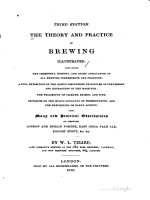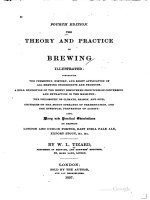Springer the theory and practice of revenue management 2005 ISBN1402077017
Bạn đang xem bản rút gọn của tài liệu. Xem và tải ngay bản đầy đủ của tài liệu tại đây (17.76 MB, 745 trang )
The Theory and Practice of
Revenue Management
Recent titles in the
INTERNATIONAL SERIES IN
OPERATIONS RESEARCH & MANAGEMENT SCIENCE
Frederick S. Hillier‚ Series Editor‚ Stanford University
Ramík, J. & Vlach, M. / GENERALIZED CONCAVITY IN FUZZY OPTIMIZATION
AND DECISION ANALYSIS
Song, J. & Yao, D. / SUPPLY CHAIN STRUCTURES: Coordination, Information and
Optimization
Kozan, E. & Ohuchi, A. / OPERATIONS RESEARCH/MANAGEMENT SCIENCE AT WORK
Bouyssou et al. / AIDING DECISIONS WITH MULTIPLE CRITERIA: Essays in
Honor of Bernard Roy
Cox, Louis Anthony, Jr. / RISK ANALYSIS: Foundations, Models and Methods
Dror, M., L'Ecuyer, P. & Szidarovszky, F. / MODELING UNCERTAINTY: An Examination
of Stochastic Theory, Methods, and Applications
Dokuchaev, N. / DYNAMIC PORTFOLIO STRATEGIES: Quantitative Methods and Empirical Rules
for Incomplete Information
Sarker, R., Mohammadian, M. & Yao, X. / EVOLUTIONARY OPTIMIZATION
Demeulemeester, R. & Herroelen, W. / PROJECT SCHEDULING: A Research Handbook
Gazis, D.C. / TRAFFIC THEORY
Zhu, J. / QUANTITATIVE MODELS FOR PERFORMANCE EVALUATION AND BENCHMARKING
Ehrgott, M. & Gandibleux, X. / MULTIPLE CRITERIA OPTIMIZATION: State of the Art Annotated
Bibliographical Surveys
Bienstock, D. / Potential Function Methods for Approx. Solving Linear Programming Problems
Matsatsinis, N.F. & Siskos, Y. / INTELLIGENT SUPPORT SYSTEMS FOR MARKETING
DECISIONS
Alpern, S. & Gal, S./ THE THEORY OF SEARCH GAMES AND RENDEZVOUS
Hall, R. W./HANDBOOK OF TRANSPORTATION SCIENCE Ed.
Glover, F. & Kochenberger, G.A. /HANDBOOK OF METAHEURISTICS
Graves, S.B. & Ringuest, J.L. / MODELS AND METHODS FOR PROJECT SELECTION:
Concepts from Management Science, Finance and Information Technology
Hassin, R. & Haviv, M./ TO QUEUE OR NOT TO QUEUE: Equilibrium Behavior in Queueing
Systems
Gershwin, S.B. et al/ ANALYSIS & MODELING OF MANUFACTURING SYSTEMS
Maros, I./ COMPUTATIONAL TECHNIQUES OF THE SIMPLEX METHOD
Harrison, T., Lee, H. & Neale, J./ THE PRACTICE OF SUPPLY CHAIN MANAGEMENT: Where
Theory And Application Converge
Shanthikumar, J.G., Yao, D. & Zijm, W.H./ STOCHASTIC MODELING AND OPTIMIZATION
OF MANUFACTURING SYSTEMS AND SUPPLY CHAINS
J./ GRID RESOURCE MANAGEMENT: State of the Art
and Future Trends
Thissen, W.A.H. & Herder, P.M./ CRITICAL INFRASTRUCTURES: State of the Art in Research
and Application
Carlsson, C., Fedrizzi, M., & Fullér, R./ FUZZY LOGIC IN MANAGEMENT
Soyer, R., Mazzuchi, T.A., & Singpurwalla, N.D./ MATHEMATICAL RELIABILITY: An
Expository Perspective
Nabrzyski, J., Schopf,
* A list of the early publications in the series is at the end of the book *
THE THEORY AND PRACTICE OF
REVENUE MANAGEMENT
KALYAN T. TALLURI
GARRETT J. VAN RYZIN
Department of Economics and Business
Universitat Pompeu Fabra
Barcelona
Graduate School of Business
Columbia University
New York
KLUWER ACADEMIC PUBLISHERS
NEW YORK, BOSTON, DORDRECHT, LONDON, MOSCOW
eBook ISBN:
Print ISBN:
1-4020-7933-8
1-4020-7701-7
©2005 Springer Science + Business Media, Inc.
Print ©2004 Kluwer Academic Publishers
Boston
All rights reserved
No part of this eBook may be reproduced or transmitted in any form or by any means, electronic,
mechanical, recording, or otherwise, without written consent from the Publisher
Created in the United States of America
Visit Springer's eBookstore at:
and the Springer Global Website Online at:
To Cristina and Uma
for the love and joy‚
K.T.
To Mary Beth‚
Stephanie‚ Claire and
Andrea with love and
thanks‚ and to the
memory of my father
John R. van Ryzin‚
G.V.
This page intentionally left blank
Contents
Dedication
List of Figures
List of Tables
Preface
Acknowledgments
1. INTRODUCTION
1.1 What Is “RM”?
1.1.1 Demand-Management Decisions
1.1.2 What’s New About RM?
1.2 The Origins of RM
1.2.1 Airline History
1.2.2 Consequences of the Airline History
1.3 A Conceptual Framework for RM
1.3.1 The Multidimensional Nature of Demand
1.3.2 Linkages Among Demand-Management Decisions
1.3.3 Business Conditions Conducive to RM
1.3.4 Industry Adopters Beyond the Airlines
1.4 An Overview of a RM System
1.5 The State of the RM Profession
1.6 Chapter Organization and Reading Guide
1.6.1
Chapter Organization
1.6.2 Reading Guide
1.7 Notes and Sources
v
xvii
xxi
xxv
xxxi
1
1
2
4
6
6
10
11
11
12
13
16
17
18
20
20
22
23
viii
THE THEORY AND PRACTICE OF REVENUE MANAGEMENT
Part I Quantity-based RM
2. SINGLE-RESOURCE CAPACITY
CONTROL
2.1 Introduction
2.1.1 Types of Controls
2.1.2 Displacement Cost
2.2 Static Models
2.2.1 Littlewood’s Two-Class Model
2.2.2
Models
2.2.3 Computational Approaches
2.2.4 Heuristics
2.3 Adaptive Methods
2.3.1 Adaptive Algorithm
2.3.2 A Numerical Comparison with EMSR and Censored Forecasting
2.4 Group Arrivals
2.5 Dynamic Models
2.5.1 Formulation and Structural Properties
2.5.2 Optimal Policy
2.6 Customer-Choice Behavior
2.6.1 Buy-Up Factors
2.6.2 Discrete-Choice Models
2.7 Notes and Sources
52
56
57
58
59
62
62
64
75
3. NETWORK CAPACITY CONTROL
3.1 Introduction
3.1.1 The Promise and Challenge of Network Control
3.1.2 Types of Controls
3.2 The Theory of Optimal Network Controls
3.2.1 The Structure of Optimal Controls
3.2.2 Bid Price Controls
3.2.3 Nonoptimality of Bid-Price Controls
3.2.4 Evidence in Support of Bid Prices
3.2.5 Bid Prices and Opportunity Cost
3.3 Approximations Based on Network Models
3.3.1 The Deterministic Linear Programming Model
3.3.2 The Probabilistic Nonlinear Programming Model
3.3.3 The Randomized Linear Programming Model
81
81
82
83
87
88
89
90
91
91
92
93
95
98
27
27
28
32
33
35
36
41
44
50
50
ix
Contents
3.4
Approximations Based on Decomposition
3.4.1 OD Factors Method
3.4.2 Prorated EMSR
3.4.3 Displacement-Adjusted Virtual Nesting (DAVN)
3.4.4 Dynamic Programming Decomposition
3.4.5 Iterative Decomposition Methods
Stochastic Gradient Methods
3.5.1 Continuous Model with Gradient Estimates
3.5.2 Discrete Model with First-Difference Estimates
Asymptotic Analysis of Network Problems
3.6.1 Asymptotic Optimality of Partitioned Controls
3.6.2 Asymptotic Optimality of Bid-Price Controls
3.6.3 Comments on Asymptotic Optimality
Decentralized Network Control: Airline Alliances
Notes and Sources
100
101
102
103
107
108
111
112
116
118
118
120
120
121
122
4. OVERBOOKING
4.1 Business Context and Overview
4.1.1 A History of Legal Issues in Airline Overbooking
4.1.2 Managing Denied-Service Occurrences
4.1.3 Lessons Beyond the Airline Industry
4.2 Static Overbooking Models
4.2.1 The Binomial Model
4.2.2 Static-Model Approximations
4.2.3 Customer Class Mix
4.2.4 Group Cancellations
4.3 Dynamic Overbooking Models
4.3.1 Exact Approaches
4.3.2 Heuristic Approaches Based on Net Bookings
4.4 Combined Capacity-Control and Overbooking Models
4.4.1 Exact Methods for No-Shows
4.4.2 Class-Dependent No-Show Refunds
4.4.3 Exact Methods for Cancellations
4.4.4 Class-Dependent Cancellation Refunds
4.5 Substitutable Capacity
4.5.1 Model and Formulation
4.5.2 Joint Optimal Overbooking Levels
4.6 Network Overbooking
129
130
131
135
137
138
139
147
149
150
152
152
154
155
156
158
159
160
161
162
164
166
3.5
3.6
3.7
3.8
x
THE THEORY AND PRACTICE OF REVENUE MANAGEMENT
4.7
Notes and Sources
168
Part II Price-based RM
5. DYNAMIC PRICING
5.1 Introduction and Overview
5.1.1 Price versus Quantity-Based RM
5.1.2 Industry Overview
5.1.3 Examples of Dynamic Pricing
5.1.4 Modeling Dynamic Price-Sensitive Demand
5.2 Single-Product Dynamic Pricing Without Replenishment
5.2.1 Deterministic Models
5.2.2 Stochastic Models
5.3 Single-Product Dynamic Pricing with Replenishment
5.3.1 Deterministic Models
5.3.2 Stochastic Models
5.4 Multiproduct‚ Multiresource Pricing
5.4.1 Deterministic Models Without Replenishment
5.4.2 Deterministic Models with Replenishment
5.4.3 Stochastic Models
5.4.4 Action-Space Reductions
5.5 Finite-Population Models and Price Skimming
5.5.1 Myopic Customers
5.5.2 Strategic Customers
5.6 Promotions Optimization
5.6.1 An Overview of Promotions
5.6.2 Retailer Promotions
5.6.3 Trade-Promotion Models
5.7 Notes and Sources
175
175
176
177
179
182
187
188
200
209
209
212
215
216
218
219
220
223
223
226
229
229
232
234
235
6. AUCTIONS
6.1 Introduction and Industry Overview
6.1.1 An Overview of Auctions in Practice
6.1.2 Types of Auctions
6.2 Independent Private-Value Theory
6.2.1 Independent Private-Value Model and Assumptions
6.2.2 An Informal Analysis of Sealed-Bid‚ First- and
Second-Price Auctions
241
241
242
245
247
247
248
xi
Contents
6.2.3
6.2.4
6.2.5
6.2.6
6.2.7
6.3
6.4
6.5
6.6
Part III
Formal Game-Theoretic Analysis
Revenue Equivalence
Optimal Auction Design
Relationship to List Pricing
Departures from the Independent Private-Value
Model
Optimal Dynamic Single-Resource Capacity Auctions
6.3.1 Formulation
6.3.2 Optimal Dynamic Allocations and Mechanisms
6.3.3 Comparisons with Traditional RM
Optimal Dynamic Auctions with Replenishment
6.4.1 Dynamic Programming Formulation
6.4.2 Optimal Auction and Replenishment Policy
6.4.3 Average-Profit Criterion
6.4.4 Comparison with a List-Price Mechanism
Network Auctions
6.5.1 Problem Definition and Mechanism
6.5.2 Equilibrium Analysis
6.5.3 Relationship to Traditional Auctions
6.5.4 Relationship to Traditional Network RM
6.5.5 Revenue Maximization and Reserve Prices
Notes and Sources
254
257
259
262
266
272
272
274
278
280
281
282
284
285
288
289
290
291
291
293
294
Common Elements
7. CUSTOMER-BEHAVIOR AND
MARKET-RESPONSE MODELS
7.1 The Independent-Demand Model
7.2 Models of Individual Customer Choice
7.2.1 Reservation-Price Models
7.2.2 Random-Utility Models
7.2.3 Customer Heterogeneity and Segmentation
7.3 Models of Aggregate Demand
7.3.1 Demand Functions and Their Properties
7.3.2 Multiproduct-Demand Functions
7.3.3 Common Demand Functions
7.3.4 Stochastic-Demand Functions
7.3.5 Rationing Rules
7.4 Notes and Sources
301
301
303
303
304
308
310
311
320
321
327
330
330
xii
THE THEORY AND PRACTICE OF REVENUE MANAGEMENT
8. THE ECONOMICS OF RM
333
8.1 Introduction
333
8.2 Perfect Competition
336
336
8.2.1 Perfectly Competitive Markets
8.2.2 Firm-Level Decisions Under Perfect Competition 338
338
8.2.3 Precommitment and Demand Uncertainty
341
8.2.4 Peak-Load Pricing Under Perfect Competition
8.2.5 Identifiable Peak Periods
341
343
8.2.6 Uncertainty over the Timing of Peak Loads
345
8.2.7 Advance Purchases in Competitive Markets
349
8.3 Monopoly Pricing
350
8.3.1 Single-Price Monopoly
8.3.2 Monopoly with Capacity Constraints
351
8.3.3 Multiple-Price Monopoly and Price Discrimination 352
8.3.4 Strategic Customer Behavior
363
369
8.3.5 Optimal Mechanism Design for a Monopolist
8.3.6 Advance Purchases and Peak-Load Pricing Un372
der Monopoly
8.4 Price and Capacity Competition in an Oligopoly
375
8.4.1 Static Models
376
8.4.2 Dynamic Models
388
8.4.3 Product Differentiation
395
402
8.5 Notes and Sources
9. ESTIMATION AND FORECASTING
9.1 Introduction
9.1.1 The Forecasting Module of RM Systems
9.1.2 What Forecasts Are Required?
9.1.3 Data Sources
9.1.4 Design Decisions
9.2 Estimation Methods
9.2.1 Estimators and Their Properties
9.2.2 MSB Estimators
9.2.3 Maximum-Likelihood (ML) Estimators
9.2.4 Method of Moments and Quantile Estimators
9.2.5 Endogeneity‚ Heterogeneity‚ and Competition
9.3 Forecasting Methods
9.3.1 Ad-Hoc Forecasting Methods
9.3.2 Time-Series Forecasting Methods
407
407
408
410
412
415
419
420
422
425
427
428
433
434
439
xiii
Contents
9.4
9.5
9.6
9.7
9.3.3 Stationary Time-Series Models
9.3.4 Nonstationary Time-Series Models
9.3.5 Box-Jenkins Identification Process
9.3.6 Bayesian Forecasting Methods
9.3.7 State-Space Models and Kalman Filtering
9.3.8 Machine-Learning (Neural-Network) Methods
9.3.9 Pick-up Forecasting Methods
9.3.10 Other Methods
9.3.11 Combining Forecast Methods
Data Incompleteness and Unconstraining
9.4.1 Expectation-Maximization (EM) Method
9.4.2 Gibbs Sampling
9.4.3 Kaplan-Meir Product-Limit Estimator
9.4.4 Plotting Procedures
9.4.5 Projection-Detruncation Method
Error Tracking and System Control
9.5.1 Estimation Errors
9.5.2 Forecasting Errors and System Control
Industry Models of RM Estimation and Forecasting
9.6.1 Airline No-Show and Cancellations Forecasting
9.6.2 Groups Demand and Utilization Forecasting
9.6.3 Sell-Up and Recapture Forecasting
9.6.4 Retail Sales Forecasting
9.6.5 Media Forecasting
9.6.6 Gas-Load Forecasting
Notes and Sources
10. INDUSTRY PROFILES
10.1 Airlines
10.1.1 History
10.1.2 Customers‚ Products‚ and Pricing
10.1.3 RM Practice
10.2 Hotels
10.2.1 Customers‚ Products‚ and Pricing
10.2.2 RM Practice
10.3 Rental Car
10.3.1 Customers‚ Products‚ and Pricing
10.3.2 RM Practice
442
447
449
450
458
464
470
472
472
473
474
481
483
484
485
486
487
496
499
499
502
504
505
508
510
511
515
515
515
516
521
524
524
526
531
531
532
xiv
THE THEORY AND PRACTICE OF REVENUE MANAGEMENT
10.4 Retailing
10.4.1 Customers‚ Products‚ and Pricing
10.4.2 RM Practice
10.5 Media and Broadcasting
10.5.1 Customers‚ Products‚ and Pricing
10.5.2 RM Practice
10.6 Natural-Gas Storage and Transmission
10.6.1 Customers‚ Products‚ and Pricing
10.6.2 RM Practice
10.7 Electricity Generation and Transmission
10.7.1 Industry Structure
10.7.2 Customers‚ Products‚ and Pricing
10.7.3 RM Practice
10.8 Tour Operators
10.8.1 Customers‚ Products‚ and Pricing
10.8.2 Capacity Management and Base-Price Setting
10.8.3 RM Practice
10.9 Casinos
10.9.1 Customers‚ Products‚ and Pricing
10.9.2 RM Practice
10.10 Cruise Ships and Ferry Lines
10.10.1 Customers‚ Products‚ and Prices
10.10.2 RM Practice
10.11 Passenger Railways
10.11.1 Customers‚ Products‚ and Pricing
10.11.2 RM Practice
10.12 Air Cargo
10.12.1 Customers‚ Products‚ and Pricing
10.12.2 RM Practice
10.13 Freight
10.13.1 Customers‚ Products‚ and Pricing
10.13.2 RM Practice
10.14 Theaters and Sporting Events
10.14.1 Customers‚ Products‚ and Pricing
10.14.2 Ticket Scalping and Distribution
10.14.3 RM Practice
10.15 Manufacturing
533
534
541
542
543
545
546
547
550
551
552
554
554
555
556
556
558
559
559
559
560
560
561
561
561
563
563
563
563
564
565
566
567
567
567
571
574
Contents
10.15.1 Customers‚ Products‚ and Pricing
10.15.2 RM Practice
10.16 Notes and Sources
xv
574
575
576
11. IMPLEMENTATION
11.1 Segmentation and Product Design
11.1.1 Segmentation
11.1.2 Product Design
11.2 System Architecture‚ Hardware‚ Software‚ and Interfaces
11.2.1 Hardware Requirements
11.2.2 User-Interface Design
11.2.3 GDS‚ CRS‚ and PMS Interfaces
11.2.4 Retail Management Systems
11.3 Revenue-Opportunity Assessment and Revenue-Benefits
Measurement
11.3.1 Revenue-Opportunity Assessment
11.3.2 Revenue-Benefits Measurement
11.4 RM Simulation
11.4.1 Generating Aggregate Number of Customers
11.4.2 Generating the Customer-Arrival Pattern
11.5 Customer Perceptions and Reactions
11.5.1 RM Perception Problems
11.5.2 Managing Perceptions
11.5.3 Overbooking Perceptions
11.6 Cultural‚ Organizational‚ and Training Issues
11.6.1 Changes in Responsibility by Function
11.6.2 Project and Organizational Structure
11.6.3 Training
11.7 Notes and Sources
579
579
580
585
594
594
594
598
605
Appendices
A Notation
B Probability
C Convexity and Optimization
D Dynamic Programming
E The Theory of Choice
F Game Theory
631
631
635
643
651
657
667
608
608
610
611
613
613
614
614
618
619
620
620
623
627
628
xvi
THE THEORY AND PRACTICE OF REVENUE MANAGEMENT
References
671
Index
709
List of Figures
A firm’s demand landscape
RM process flow
Booking limits
protection levels
and bid
prices
2.2
Optimal protection level
in the static model
Monte Carlo estimates of optimal protection levels
2.3
for 50 simulated data points
Adaptive-method example 1
2.4
Adaptive-method example 2
2.5
2.6
Optimal protection level
in the dynamic model
2.7
Scatter plot of Q(S) and R(S)
Network examples
3.1
3.2
Comparison of DLP‚ RLP‚ and dynamic programming decomposition
A network example
3.3
3.A.1 Stochastic gradient calculation for nested booking
limits: gradient equal to zero
3.A.2 Stochastic gradient calculation for nested booking
limits: gradient nonzero
Overbooking notification statement
4.1
Overbooking limits over time
4.2
Overbooking
for the multiclass and binomial models
4.3
Network overbooking
4.4
Sample price path at a discount air carrier
5.1
1.1
1.2
2.1
11
19
29
39
44
54
55
61
69
82
100
115
127
127
134
140
165
168
181
xviii
5.2
5.3
5.4
5.5
5.6
5.7
6.1
6.2
6.3
6.4
7.1
7.2
7.3
8.1
8.2
8.3
8.4
8.5
8.6
9.1
9.2
9.3
9.4
9.5
9.6
9.7
9.8
9.9
9.10
9.11
9.12
9.13
9.14
THE THEORY AND PRACTICE OF REVENUE MANAGEMENT
The maximum concave envelope produced by discrete prices
Sales volume example
Effect of markdowns
An example of the optimal price path in the stochastic case
A six-node‚ two-hub airline network
Optimal price-skimming solution for myopic customers
Perturbing the bid in a second-price auction
Illustration of the direct-revelation mechanism
Optimal allocations in the dynamic auction model
Optimal allocations in the dynamic-auction model
with replenishment
Individual demand and the aggregate demand
Revenue and marginal-revenue curves
Some common aggregate price-response functions
Revenue from selling a product at multiple prices
The equilibrium bipartite graph
Response functions for a duopoly RM game
The two cases for the function
Best response cycle example
No-purchase probabilities causing a best-response cycle
Forecasting module in a RM system
Wedge-shaped bookings data
Time series components
Exponential smoothing with different smoothing
parameters
Sample ACF and PACF functions
ACF and PACF examples
The hierarchial Bayes model
Kalman filter smoothing
Neural network example
Neural network activation functions
Incremental booking data
Over-fitting example
Booking curve with cancellations and no-shows
Cancellation probabilities as a function of booking time
196
198
200
204
218
225
249
257
275
284
311
319
323
355
382
383
400
400
401
409
416
435
437
443
446
454
463
465
467
471
495
500
501
List of Figures
9.15
9.16
10.1
10.2
10.3
10.4
10.5
10.6
10.7
10.8
10.9
10.10
10.11
11.1
11.2
11.3
11.4
11.5
11.6
11.7
11.8
11.9
11.10
11.11
Induction tree on cancellations data
Neural network for gas-load forecasting
Pricing an air travel itinerary
Revenue sources and revenue drivers for a hotel
A rental car RM system implementation
Store type breakdown for the top 200 retailers
Growth of department store markdowns
Gas pipeline network
Electricity industry structures
Capacity planning at a tour operator
Purchase plan and price setting at a tour operator
RM process for tour-operators
Washington Opera Kennedy Center layout
Advance-purchase and max-stay restrictions for an
airline trip represented by a grid
Products and customers utility reduction modeling
Nightly batch processing
Forecasting under the independent-class model
RM process flow
Quantity-based RM user interface
Quantity-based RM user interface
GDS reservation processing
Seamless availability
Generating arrivals over time
RM organization charts
xix
503
510
519
526
533
535
537
551
553
557
557
558
573
590
591
595
596
597
598
599
600
604
613
625
This page intentionally left blank
List of Tables
2.1
2.2
2.3
2.4
2.5
2.6
2.7
2.8
2.9
2.10
2.11
2.12
2.13
2.14
3.1
3.2
3.3
Static single-resource model and protection levels
48
Revenue performance for Example 2.3
49
Static single-resource model data for Example 2.4
49
Revenue performance for Example 2.4
50
Fares, demand statistics, and protection levels for
53
adaptive-method numerical examples
Starting values of protection levels for adaptive53
method numerical examples
Fare-product revenues and restrictions for Example 2.5 65
65
Segments and their characteristics for Example 2.5
Choice probabilities
probability of purchase
Q(S), and expected revenue R(S) for Example 2.5
66
Illustration of nested policy for Example 2.5
72
The different segment choices in Example 2.5 if
all classes are open and resulting demand for a
74
population size of 20
75
Inputs to the EMSR-b model
Protections for the EMSR-b model without and
75
with buy-up factors
Simulation results comparison between choice dynamic program and EMSR-b with buy-up
75
Example of a bid price table for a single resource
90
based on remaining time and remaining capacity
Problem data for the bid price counterexample
90
111
Data for the iterative proration-method example
xxii
3.4
3.5
3.6
3.7
4.1
4.2
4.3
4.4
5.1
5.2
5.3
5.4
5.5
5.6
5.7
5.8
6.1
6.2
6.3
6.4
6.5
7.1
7.2
THE THEORY AND PRACTICE OF REVENUE MANAGEMENT
Example of convergence of the iterative proration
method
Data for the Williamson [566] network example
Initial protection levels produced by DAVN
Improved protection levels produced by the stochastic gradient algorithm
U.S. major airline denied-boarding rates‚ 1990-2000
Binomial and normal approximation overbooking
probabilities
Comparison of normal and Gram-Charlier (G-C)
approximations
Empirical distribution of group sizes
Allocations of capacity between periods 1 and 2
and the marginal values and total revenue
Example of the marginal-allocation algorithm
Example of discrete prices and revenues
Solution of a linear program for the discrete-price
example
Results of different markdown policies on 60 markdown styles
Example performance of the deterministic price
heuristic
Demand-function parameters‚ itineraries‚ and optimal solution for Example 5.6
Empirical generalizations on promotions
Dynamic auction revenues for different concentrations of customers
DLPCC suboptimality gaps relative to a dynamic
auction for different demand to capacity ratios
Dynamic auction and replenishment profits for different numbers of customers
Dynamic auction and replenishment profits for different holding costs
Network auction simulation results: average revenues as a function of reserve price
Attribute weights
for attributes
in
alternative
Estimated elasticities (absolute values) for common products
111
115
116
116
133
143
149
150
190
192
195
195
200
206
219
231
280
280
287
288
294
311
314
List of Tables
7.3
8.1
8.2
8.3
8.4
9.1
9.2
9.3
9.4
10.1
10.2
10.3
10.4
10.5
10.6
10.7
10.8
10.9
10.10
10.11
10.12
10.13
10.13
10.14
10.15
11.1
11.2
Common demand functions
Prices and capacities for Example 8.2 without an
advance-purchase market
Prices and capacities for Example 8.3 with an advancepurchase market
Revenue and variance calculations for Example 8.9
with a single-price policy
Revenue and variance calculations for Example 8.9
with a multiple-price policy
Assumptions of ordinary least-squares (OLS) estimation
Means and covariances of some stationary timeseries processes
Results of the AR(2) forecasting example
EM algorithm iterations on constrained data
An example of airline fare codes‚ classes‚ and their
restrictions
Features of a hotel property management system
(PMS)
World’s top 10 retailers‚ store types‚ and their revenues for the year 2002
U.S. Apparel sales by channel
U.S. apparel sales by category
Inventory definitions in television‚ radio‚ and print
media
A sample advertising purchase plan
An example of a pipeline delivery contract
Sample pipeline tariffs
Sample natural gas transportation and storage products
Amtrak accommodation and fare types
Sample freight product differentiation
An example of ticket categories for a broadway show
(continued) An example of ticket categories for a
broadway show
Washington Opera Kennedy Center pricing (2003–
2004 season)
The Mets four-tier pricing plan (year 2002)
Customer segments and subsegments by industry
Classification of segment bases
xxiii
322
347
349
361
361
424
445
448
478
522
528
534
537
538
544
544
547
548
549
562
565
568
569
573
574
581
582
xxiv
11.3
11.3
11.4
11.5
11.6
11.7
11.8
11.9
11.10
11.11
11.12
THE THEORY AND PRACTICE OF REVENUE MANAGEMENT
Some common segment bases used in RM
(continued) Some common segment bases used in RM
Attributes and their levels for a hotel application
Major global distribution systems (GDSs) as of 1998
An availability request message as software code
and the same request as a message
Typical data tables provided by a hotel PMS
Table BIDPRICE
RMS pricing and inventory functions
Functionality of EDI for the travel and tourism
industries
Commonly tracked RM system performance measures
Task list for a RM implementation
583
584
586
601
602
602
603
607
609
612
624









